
![]()
Search the Journey to Forever website – click HERE
|
Journey to Forever: Make a donation |
Navigation
| Small farms library | |
| City farms | |
| Organic gardening | |
| Journey to Forever organic garden Handmade soil Village development |
|
| Why organic? | |
| Do it for selfish reasons No pesticides Food quality |
|
| Building a square foot garden | |
| Where to build it Is the soil fertile enough? Raised beds and double-digging The lazy way Paths The sides Sizes and shapes Trellises Cement Soil No compost? |
|
| Plant spacing guides | |
| No ground? Use containers | |
| Container gardening guide Resources |
|
| When to sow what | |
| Sowing times for different regions Seed sowing and harvesting times for Hong Kong Vegetable Garden Calendar for Hong Kong |
|
| Seeds | |
| Catalogs Supplies Herbs Hong Kong |
|
| Garden pond | |
| Pond resources | |
| Gardening resources | |
| Organics resources | |
| Square foot gardens | |
| Companion planting | |
| How much to grow? | |
| General gardening | |
| Herbs | |
| Composting | |
| Small farms | |
Contact usTo Keith Addison Handmade Projects |
Gardening resources
Organics resources
Classic works
The Journey to Forever Small Farms Library provides free full-text online access to the essential texts on sustainable farming and gardening and related topics. It includes many classics that are now difficult to find. This is the foundation work that put organic farming and gardening on a sound scientific basis in the first half of the 20th century, and put it into practice around the world. There are no modern replacements for these books. The Biodynamic system of organic growing was founded by Rudolf Steiner: it has its mystical side, along with high-quality results backed up by scientific research and studies. Biodynamic farmers make excellent compost using homeopathic plant preparations. The following two links are a good gateway to the world of biodynamic farming and growing. Set up in 1995, the OGL list (Organic Gardening Discussion List) hosts lively, informative discussions on a wide range of organic gardening and related topics. Send a message saying (in the body) Organics resources
An Agricultural Testament by Sir Albert Howard, Oxford University Press, 1940.
This is the book that started the organic farming and gardening revolution, the result of Howard's 25 years of research at Indore in India. The essence of organics is brilliantly encapsulated in the Introduction, which begins: "The maintenance of the fertility of the soil is the first condition of any permanent system of agriculture." Read on! Full explanation of the Indore composting process and its application. Excellent on the relationship between soil, food and health. Full text online at the Journey to Forever Small Farms Library.
Farming and Gardening for Health or Disease (The Soil and Health) by Sir Albert Howard, Faber and Faber, London, 1945, Devin-Adair 1947, Schocken 1972
This is Howard's follow-up to An Agricultural Testament, extending its themes and serving as a guide to the new organic farming movement as it unfolded -- and encountered opposition from the chemical farming lobby and the type of agricultural scientists Howard referred to as "laboratory hermits". Together, the two books provide a clear understanding of what health is and how it works. Full text online at the Journey to Forever Small Farms Library.
The Waste Products of Agriculture -- Their Utilization as Humus by Albert Howard and Yeshwant D. Wad, Oxford University Press, London, 1931
Where Howard's An Agricultural Testament charts a new path for sustainable agriculture, this previous book describes how the Indore composting system which was the foundation of the new movement was developed, and why. Howard's most important scientific publication. Full text online at the Journey to Forever Small Farms Library.
The Earth's Green Carpet by Louise E. Howard, 1947, Faber & Faber, London
In this unusually clear book, Lady Howard (Sir Albert Howard's wife), has written a "layman's introduction" which is also a work of literary distinction. Her subject is nothing less than the life cycle studied as a whole, and this leads inevitably to the importance of a reformed agriculture for the health of the community. She saw the need for a popular introduction to her husband's revolutionary ideas and principles, and her book draws a vivid picture of what lies behind the appearance of the Earth's green carpet. "Nature is not concerned to give us simple lessons," Lady Howard says -- and yet she transmits them here with admirable simplicity and clarity, a delight to read. More than an introduction, the book is a survey of the whole body of work of the pioneers of organic farming and growing. Full text online at the Journey to Forever Small Farms Library.
Sir Albert Howard in India by Louise E. Howard, Faber & Faber, London, 1953, Rodale 1954
Albert and Gabrielle Howard worked as fellow plant scientists and fellow Imperial Economic Botanists to the Government of India for 25 years, and this is a study of their work by Sir Albert's second wife Louise (sister of Gabrielle, who died in 1930). It's a classic study of effective Third World development work. Initially involved with improving crop varieties, the pair soon concluded it was futile to fiddle with seeds unless the work took full account of the system and circumstances as a whole. Thus developed a sustained interest in putting agricultural research into its right relation with the needs of the people, and a fundamental belief in peasant wisdom. Results were useful only if they could be translated into peasant practice. This led to the development of the famous Indore system of composting organic wastes: improved seeds were no use in impoverished soils. It's a great story. Full text online.
See a review of Albert Howard's work, plus a short bibliography and links to his major works and some of his published papers, at
"Towards a Sustainable Agriculture -- The Living Soil", by Lady Eve Balfour. This classic text on the organic movement is an address given by the late Lady Eve Balfour, author of the organics classic The Living Soil and the Haughley Experiment, to an IFOAM (International Federation of Organic Agriculture Movements) conference in Switzerland in 1977. Full text online at the Journey to Forever Small Farms Library.
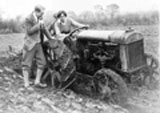
Lady Eve Balfour at Haughley (The Soil Association)
"The Living Soil" by Lady Eve B. Balfour, Faber and Faber, London, 1943
Eve Balfour was one of the key figures in the forming of the organic gardening and farming movement, and one of the founders of Britain's Soil Association. She divided her farm at Haughley in England into two sections, one organic, and the other run "conventionally", with chemical fertilizers. This book records the results, and her insights. "The health of soil, plant, animal and man is one and indivisible," she said. She practised what she preached, and reaped the benefits -- Lady Eve died in her 90s, healthy and alert to the end. This is an informative, thoughtful and inspiring book any gardener will want to read. Full text online at the Soil and Health Library:
http://www.soilandhealth.org/
The Medical Testament published by the 31 doctors of the Cheshire Panel Committee in England on March 22 1939 was a milestone in the development of the infant organic farming movement. It acknowledged great advances in the realm of cures, but rather the opposite when it came to prevention. It also explained why this was so, and offered the remedy, plus the proof of it: "A fertile soil means healthy crops, healthy animals and healthy human beings." This is a classic document, now long out of print -- a lost classic. We tracked down a copy of the original pamphlet, plus some of the associated documents and publications -- 15 papers in all, virtually a book, all available in full-text online at the Journey to Forever Small Farms Library. This is what organics is all about.
Weeds -- Guardians of the Soil by Joseph A. Cocannouer, Devin-Adair, 1950. Professor Cocannouer, who taught biology and conservation for 50 years, demonstrates how the controlled use of weeds is sound ecology, good conservation and a boon to the gardener. Weeds grow for a reason -- learn to work with them instead of fighting them. Full text online at the Small Farms Library
Quality check
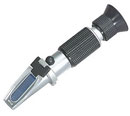 Extech RF15 Refractometer -- 0-32% Brix Sucrose Refractometer with Automatic Temperature Compensation. Measures the concentration of sugar from 0 to 32% Brix. Max resolution 0.2% Brix. Only requires 2 or 3 drops. Simple, repeatable measurements. See Brix levels for full details and quality chart. Buy at Amazon.com:
Extech RF15 Refractometer -- 0-32% Brix Sucrose Refractometer with Automatic Temperature Compensation. Measures the concentration of sugar from 0 to 32% Brix. Max resolution 0.2% Brix. Only requires 2 or 3 drops. Simple, repeatable measurements. See Brix levels for full details and quality chart. Buy at Amazon.com:
Extech RF15 Refractometer "The New Organic Grower -- A Master's Manual of Tools and Techniques for the Home and Market Gardener" by Eliot Coleman, Chelsea Green, Vermont, 1989, 1995, ISBN 0-939931-75-X
"The New Organic Grower -- A Master's Manual of Tools and Techniques for the Home and Market Gardener" by Eliot Coleman, Chelsea Green, Vermont, 1989, 1995, ISBN 0-939931-75-X
By a master -- "a quiet leader in the American organic movement". This book is for anyone serious about the subject. Coleman is an organic farmer and gardening tools consultant, and he and his wife host the popular TV series "Gardening Naturally" on the Learning Channel. Buy from Amazon.com: The New Organic Grower
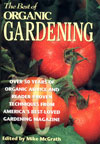 "The Best of Organic Gardening" edited by Mike McGrath of Rodale, Rodale Press, Pennsylvania, 1996, ISBN 0-87596-646-2
"The Best of Organic Gardening" edited by Mike McGrath of Rodale, Rodale Press, Pennsylvania, 1996, ISBN 0-87596-646-2
"Over 50 years of organic advice and reader-proven techniques from America's best-loved gardening magazine." J.I. Rodale was inspired by the work of Sir Albert Howard to found Rodale's organic research farm (now the Rodale Institute) and launch Organic Gardening magazine, and was the major influence in bringing organics to the US. This book is filled with organic savvy. Buy from Amazon.com: The Best of Organic Gardening
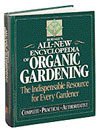 "Rodale's All-New Encyclopedia of Organic Gardening" -- a wealth of information distilled from Rodale's long years in the field of organic gardening and growing, from A-Z. Not only for organic gardeners but for all gardeners. Buy from Amazon.com: Rodale's All-New Encyclopedia of Organic Gardening
"Rodale's All-New Encyclopedia of Organic Gardening" -- a wealth of information distilled from Rodale's long years in the field of organic gardening and growing, from A-Z. Not only for organic gardeners but for all gardeners. Buy from Amazon.com: Rodale's All-New Encyclopedia of Organic Gardening
Garden Organic (HDRA), Britain's organic gardening association, has two large organic demonstration gardens, at Ryton and Spalding, runs an International Research Department, Information and Education Department, the Heritage Seed Library, Third World Organic Support Group, and constant campaigns to promote the organic message. Also the Schools Organic Network. The site has a useful set of factsheets and How-to guides (if you want to learn how to make compost this is a good place to start) -- good, practical, down-to-earth information you can use, based on years of answering inquiries from members and other gardeners.
http://www.gardenorganic.org.uk/
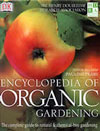 "The HDRA Encyclopedia of Organic Gardening", Dorling Kindersley, hardback, 416 pages -- The definitive organic gardening book, an essential reference for all gardeners committed to a natural, healthy and safe approach. It provides an excellent grounding in organic basics -- soil care, composting, weed control, plant health care and watering. Organic designs and plans, and chapters on ornamentals, lawns and hard landscaping help you to create your perfect organic garden. Fruit, vegetable and herb growing, outdoors, in containers and under cover is covered in detail to guide you in growing healthy, productive crops. Pauline Pears, Senior Horticultural Advisor and long-time Garden Organic-HDRA member of staff, acted as Editor-in-Chief, co-ordinating the production for HDRA. Buy from Amazon.com: The HDRA Encyclopedia of Organic Gardening
"The HDRA Encyclopedia of Organic Gardening", Dorling Kindersley, hardback, 416 pages -- The definitive organic gardening book, an essential reference for all gardeners committed to a natural, healthy and safe approach. It provides an excellent grounding in organic basics -- soil care, composting, weed control, plant health care and watering. Organic designs and plans, and chapters on ornamentals, lawns and hard landscaping help you to create your perfect organic garden. Fruit, vegetable and herb growing, outdoors, in containers and under cover is covered in detail to guide you in growing healthy, productive crops. Pauline Pears, Senior Horticultural Advisor and long-time Garden Organic-HDRA member of staff, acted as Editor-in-Chief, co-ordinating the production for HDRA. Buy from Amazon.com: The HDRA Encyclopedia of Organic Gardening
Organic gardening at LILI, the Low Impact Living Initiative: factsheets, books, courses, resources covering smallholdings, organic gardening, urban/small-space gardening, composting, greenhouses & polytunnels, herbs, meadows & grassland, natural pest & weed control, ponds, livestock &poultry, scything, seed saving, vegetable growing, wildlife gardening, more – useful resources on a wide range of topics.
http://www.lowimpact.org/topics1land.html
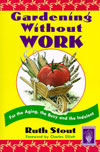 "Gardening Without Work: For the Aging, the Busy and the Indolent" by Ruth Stout, 1998, Lyons Press, ISBN 1558216545
"Gardening Without Work: For the Aging, the Busy and the Indolent" by Ruth Stout, 1998, Lyons Press, ISBN 1558216545
Queen of Mulch Ruth Stout plants and picks, and that's all. And she keeps her mulches thick: 6" thick. No weeds, no pests, no chemicals, no digging, no work. The first edition of this book came out decades ago and a whole generation of Stout fans have proved it works. Her engaging style makes this how-to book a lot of fun. Full of sage advice. Ruth Stout is living proof of her methods, and another tribute to organic gardening, like Eve Balfour: her latest book will be out soon: "Don't Forget to Smile or How to Stay Sane and Fit over Ninety". Buy from Amazon.com: Gardening Without Work
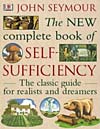 "The Complete Book of Self Sufficiency" by John Seymour, Foreword by E. F. Schumacher, 1976, revised 2003, Dorling Kindersley, ISBN 0751304263
"The Complete Book of Self Sufficiency" by John Seymour, Foreword by E. F. Schumacher, 1976, revised 2003, Dorling Kindersley, ISBN 0751304263
Seymour has been described as the 'guru' of self sufficiency and says it all in this book. From planning a 1 or 5 acre plot to crop rotation, from making bread to building a furnace. Essential accessory to self-sufficiency, whether you need to remove a tree stump, butcher livestock, harness a ploughhorse, plan a dairy or dress stone. Features many forgotten crafts that have been lost in favour of convenience food and supermarkets. Comprehensive. Great drawings and all the information you need. 312 pages. Buy from Amazon.com: The New Complete Book of Self-Sufficiency
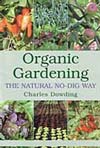 "Organic Gardening: The Natural No-Dig Way" by Charles Dowding, Green Books, 2007, 224 pages, ISBN-10: 1903998913 -- Charles Dowding is one of the pioneers of vegetable box schemes in Britain and has run a successful organic garden supplying local restaurants and shops for over 25 years. More than just a no-dig how-to book, it deals with organic gardening in general. Packed with savvy information, useful for any allotment or home grower, dig or no-dig, organic or not. Focus is on the UK but easily adapted to other conditions. Buy from Amazon.com: Organic Gardening: The Natural No-Dig Way
"Organic Gardening: The Natural No-Dig Way" by Charles Dowding, Green Books, 2007, 224 pages, ISBN-10: 1903998913 -- Charles Dowding is one of the pioneers of vegetable box schemes in Britain and has run a successful organic garden supplying local restaurants and shops for over 25 years. More than just a no-dig how-to book, it deals with organic gardening in general. Packed with savvy information, useful for any allotment or home grower, dig or no-dig, organic or not. Focus is on the UK but easily adapted to other conditions. Buy from Amazon.com: Organic Gardening: The Natural No-Dig Way
Raised Bed Agriculture -- Minifarms Network: "For home gardening raised bed agriculture means: less work, less irrigation, improved soil, higher yields and no poisons. For market gardeners, mini-farmers and mini-ranchers it means all the above plus profits. RBA creates a healthy soil to grow healthy plants to provide healthy food to feed healthy people." 2,200-word article from Ken Hargesheimer in Texas, who has taught organic growing in permanent raised beds worldwide.
http://www.minifarms.com/rba.html
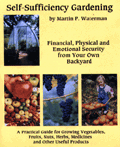 "Self-Sufficiency Gardening: Financial, Physical and Emotional Security from Your Own Backyard" by Martin P. Waterman, 1995, ISBN 1-55950-135-9
"Self-Sufficiency Gardening: Financial, Physical and Emotional Security from Your Own Backyard" by Martin P. Waterman, 1995, ISBN 1-55950-135-9
Waterman is a widely respected horticulturist and journalist. Practical guide for the novice and experienced gardeners. Covers the basics, organic growing, edible landscaping, greenhouses, preserving and storing, non-food and other valuable crops, earning income with your crops, and more. Traditional, time-honoured gardening techniques along with computer-gardening technology. Waterman writes gardening articles for Backwoods Home Magazine, among others. This is what the magazine's publisher Dave Duffy said about this book: "If you're going to read just one gardening book in the 90s, this is the book Backwoods Home Magazine will stand behind." Buy from Amazon.com: Self-Sufficiency Gardening
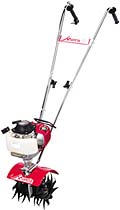 The Mantis lightweight tiller is not just a junior-sized toy cultivator, it's an effective tool that can do things a full-sized cultivator can't do, apart from working in much smaller spaces.
The Mantis lightweight tiller is not just a junior-sized toy cultivator, it's an effective tool that can do things a full-sized cultivator can't do, apart from working in much smaller spaces.
The Mantis weighs 20 pounds (9 kg). It was designed 30 years ago for professional landscape gardeners and it's the world's best-selling tiller, with more than a million sales.
The twisted "serpentine" tines spin at 240 RPM -- twice the speed of ordinary tillers, digging down to 10" (25cm), cutting through hard sod, compact soil or tough weeds, turning it all into finely textured soil ready for planting. The 9-inch (23cm) tilling width makes tilling or cultivating between rows easy.
The Mantis breaks sod and chops it up, incorporates organic matter, mixes in compost or lime, works soil in tight spaces, including raised beds, weeds between rows and among plants.
Switch the tines around and dig just a couple of inches into the soil to weed a large 30 x 40 ft garden (9 x 12 metres) in 20 minutes, chopping in the weeds as you go.
Available in three models: with an electric motor, a 2-cycle gasoline engine, or a Honda 4-cycle gasoline engine -- the Honda engine model is more powerful and quieter, it weighs 4 pounds more at 24 pounds (10.8 kg) and it's more expensive.
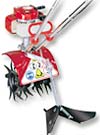 The attachments fit all three models: the Planter/Furrower has two special tines that dig deep, 6"-wide furrows in any soil -- for tomatos, corn, beans, potatoes, asparagus, onions, root crops, also for building raised beds and cutting trenches; the Plow attachment is propelled forward by the spinning tiller tines, you walk behind -- the hardened steel plow blade forms straight furrows, deep or shallow, much faster than working by hand, banks soil for planting; also Border Edger, Lawn Dethatcher, Lawn Aerator, Hedge Trimmer Bars, more.
The attachments fit all three models: the Planter/Furrower has two special tines that dig deep, 6"-wide furrows in any soil -- for tomatos, corn, beans, potatoes, asparagus, onions, root crops, also for building raised beds and cutting trenches; the Plow attachment is propelled forward by the spinning tiller tines, you walk behind -- the hardened steel plow blade forms straight furrows, deep or shallow, much faster than working by hand, banks soil for planting; also Border Edger, Lawn Dethatcher, Lawn Aerator, Hedge Trimmer Bars, more.
"The Scythe Book" by David Tresemer, 1981, Reprint 1996, Alan C. Hood, ISBN 0-911469-14-1
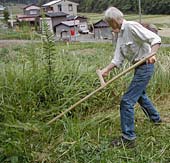
Clearing rough grass and weeds at our farm in Tamba, Japan -- we have two traditional European scythes from Slovenia, where local people still use scythes.

"In this age when most wonder how you can accomplish anything without the aid of electricity or gasoline, we must reassert that a hand tool finely made has greater versatility, has comparable efficiency even in large areas, and even makes for good exercise because the tool fits the dynamics of the body. Most importantly, a finely made tool does not interfere with personal communion with the ever-amazing natural world." A well-researched manual on the (almost) lost art of using a scythe: how to use a scythe with little effort. Tresemer delves into subjects such as the Alexander Technique, relaxation and mind-body techniques to explain the relaxed, natural swing that cuts the best -- Zen and the art of the scythe (though he doesn't say so). Interesting recounting of the history of the scythe (it took about 2,000 years to develop it). Includes sections on scythe maintenance and harvesting and processing small grains. A real pleasure to read. Buy from Amazon.com: The Scythe Book
Scythe Supply offers high-quality European-style scythes, scythe blades, snaths, whetstones, hammers, anvils and equipment. "We are scythe enthusiasts and want others to discover this wonderful tool." Lots of content and a workshop section with how-to explanations and photos.
http://www.scythesupply.com/
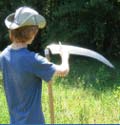 Marugg scythes -- "To our knowledge we our the only company in the U.S. still making curved hickory snaths for European style scythes." Marugg Blades are custom made by a company in Austria that has been making blades since 1540. "We are happy to report that a scythe renaissance is underway, as sustainable agricultural methods are adopted by farmers in the developed world and the internet brings availability of these awesome tools to the emerging nations. We ship worldwide. — Allen and Amy Wilson"
Marugg scythes -- "To our knowledge we our the only company in the U.S. still making curved hickory snaths for European style scythes." Marugg Blades are custom made by a company in Austria that has been making blades since 1540. "We are happy to report that a scythe renaissance is underway, as sustainable agricultural methods are adopted by farmers in the developed world and the internet brings availability of these awesome tools to the emerging nations. We ship worldwide. — Allen and Amy Wilson"
http://www.themaruggcompany.com/index.html
The Scythe Network, a co-operative group committed to promoting the use of the scythe. Technical and instructional arcticles online. Sells European blades, snaths, accessories online.
http://www.scytheconnection.com/
Biodynamics
The Biodynamic Agricultural Association of the UK -- The best place on the Web for resources on Biodynamics: What-is, FAQ, How-to's, libraries, excellent online bookstore, "Star and Furrow" journal, news, links, Bio-Dynamic Supplies, Demeter Certification and more.
http://www.biodynamic.org.uk/
Biodynamic Farming and Gardening Association (BDA) Home Page -- "Based on a series of lectures given by Austrian philosopher Rudolf Steiner in 1924, Biodynamics is a method of agriculture which seeks to actively work with the health-giving forces of nature. It is the oldest non-chemical agricultural movement, predating the organic agriculture movement by some 20 years and has now spread throughout the world."
http://www.biodynamics.com/Organics mailing lists
SUBSCRIBE OGL <Yourfirstname> <Yourlastname>
to
LISTSERV@LSV.UKY.EDU
All the messages sent by subscribers will arrive in your email box, or you can set the listserv to DIGEST format to send you one daily compilation of all that day's messages.
The 4x4Garden email discussion group is for people using biointensive gardening methods to grow a tremendous amount of food or other crops in a small gardening space. Subscribe online:
http://groups.yahoo.com/group/4x4Garden
Post message: 4x4Garden@yahoogroups.com
Subscribe: 4x4Garden-subscribe@yahoogroups.com
Unsubscribe: 4x4Garden-unsubscribe@yahoogroups.comGardening resources
Square foot gardens
Companion planting
How much to grow?
General gardening
Herbs
City farms
Organic gardening
Why organic?
Building a square foot garden
Plant spacing guides
No ground? Use containers
When to sow what
Seeds
Garden pond
Gardening resources
Composting
Making compost
Composting resources
Composting indoors
Vermicomposting
Humanure
Composting for small farms
Small farms
Small farm resources
Community-supported farms
Farming with trees
Farming with animals
Pasture
Pigs for small farms
Poultry for small farms
Aquaculture for small farms
Composting for small farms
Controlling weeds and pests
Small farms library